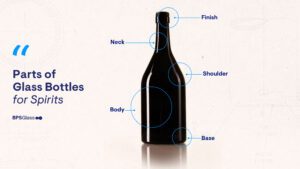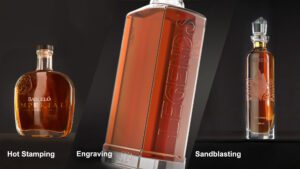Different Types of Wine Bottles

Types of Wine Bottles
You can learn a lot about what type of wine you’re buying based on the style of the bottle. Take a look at the major types of wine bottles and what wines tend to be inside.
High Shoulder
This is the most common type of bottle style. The bottle style was made popular by Bordeaux, where it’s used for Merlot, Cabernet Sauvignon, and white wines made with Sauvignon Blanc.
Sloping Shoulder
The sloping shoulder bottle is commonly used for Pinot Noir, Chardonnay, Syrah, and Grenache. Most oak-aged white wines come in this style of bottle.
Sparkling Wine and Champagne
Sparkling Wine bottles are heavier because they need to withstand the pressure of seven earth atmospheres inside. Some bottles have punts (the divot on the bottom of the bottle) and some without. Often the custom bottles designed are used for premium sparkling wines.
Various Dessert Styles
Tradition is the source of the styles of bottles used for dessert wines. These wine bottles are much more ornate than regular dry wine bottles. Producers will have custom stamps or seals, and the shapes differentiate each style of dessert wine.
Unique Bottles
The bottle styles of wine are not as unique or varied as styles for spirits. Based on a glass manufacturer’s catalog from 1906, the design of wine bottles hasn’t changed in over 100 years.
10 Explanations Why Wine Bottles Have Punts In The Bottom
Pick up your latest wine purchase and examine the bottle. Besides a long, elegant neck, a corked (or screw-capped) top, and an eye-catching label, what else do you spot? Hint: check the bottom of your bottle. If you answered a “dimple,” you just singled out one of the most mysterious features of the wine bottle, the punt.
Though not every wine has a punt in it, many do, and the reason behind the little indent isn’t clear. There’s no clear consensus on why the punt is there, but there are plenty of fascinating theories. We singled out the ten that seem most plausible (or interesting) to us. You be the wine expert: tell us which one you find most likely.
The Punt make it easier to hold a wine bottle
If you grab your wine bottle from the bottom, it’s no surprise that the punt is present, acting as a spot to place your thumb while the rest of your fingers grab the base of the bottle.
The Punt allows the bottle to stand upright
Glassblowers are used to creating punts to push the seam of a bottle up, allowing the bottle to stand upright while preventing the glass at the bottom of the bottle from sticking out and cutting people.
Punts used to be an indication that wine was well made
However, today it seems that the existence of a punt and the quality of wine have little to do with one another.
Punts create an optical illusion that a wine bottle is bigger than it is
Need we say more? If you’re comparing two 750 ml bottles, and one looks like it’s holding more juice, your eyes can often deceive your logic.
Punts catch sediment
Some posit that the angle of a punt lets sediment collect in a tight area near the base, stopping the sediment from blending back into the wine as it’s being poured.
Punts make your wine chill quicker
A punt at the bottom of a bottle increases surface area, allowing more ice to come into contact with it and thus chilling the liquid inside quicker. Maybe we should indent our beer bottles too?
A Punt prevented a bottle from being refilled
One tale states that taverns had a vertical steel pin in their bars. When consumed a bottle of wine, its bottom would be punctured with the pins, ensuring that it would not refill the bottle. We have to note that while this story is certainly colorful, it doesn’t explain why full bottles of wine contain punts.
Punts make the bottle easier to clean before you fill it with wine
Think of it this way: it’s often difficult to clean a tall glass evenly. Perhaps this is what glassblowers had in mind when making the punt. When you shoot water into a wine bottle that has a punt, the water is spread more evenly throughout the bottom of the bottle.
Punts make the bottle more resistant to high pressure
And when they’re more resistant to high pressure, they can better hold sparkling wines like Champagne and Prosecco. We can all thank punts on New Year’s.
Punts allow bottles to be more easily organized
Punts allow for more ease when it comes to stacking wine. If you’re a daily VinePair reader, we already know you’re getting excited about this organizational tip.



